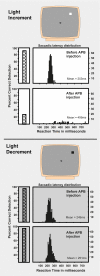Parallel information processing channels created in the retina
- PMID: 20876118
- PMCID: PMC2951406
- DOI: 10.1073/pnas.1011782107
Parallel information processing channels created in the retina
Abstract
In the retina, several parallel channels originate that extract different attributes from the visual scene. This review describes how these channels arise and what their functions are. Following the introduction four sections deal with these channels. The first discusses the "ON" and "OFF" channels that have arisen for the purpose of rapidly processing images in the visual scene that become visible by virtue of either light increment or light decrement; the ON channel processes images that become visible by virtue of light increment and the OFF channel processes images that become visible by virtue of light decrement. The second section examines the midget and parasol channels. The midget channel processes fine detail, wavelength information, and stereoscopic depth cues; the parasol channel plays a central role in processing motion and flicker as well as motion parallax cues for depth perception. Both these channels have ON and OFF subdivisions. The third section describes the accessory optic system that receives input from the retinal ganglion cells of Dogiel; these cells play a central role, in concert with the vestibular system, in stabilizing images on the retina to prevent the blurring of images that would otherwise occur when an organism is in motion. The last section provides a brief overview of several additional channels that originate in the retina.
Conflict of interest statement
The author declares no conflict of interest.
Figures




Comment in
-
Profile of Peter H. Schiller.Proc Natl Acad Sci U S A. 2011 Mar 22;108(12):4705-7. doi: 10.1073/pnas.1101955108. Epub 2011 Feb 28. Proc Natl Acad Sci U S A. 2011. PMID: 21368197 Free PMC article. No abstract available.
Similar articles
-
Profile of Peter H. Schiller.Proc Natl Acad Sci U S A. 2011 Mar 22;108(12):4705-7. doi: 10.1073/pnas.1101955108. Epub 2011 Feb 28. Proc Natl Acad Sci U S A. 2011. PMID: 21368197 Free PMC article. No abstract available.
-
How the parallel channels of the retina contribute to depth processing.Eur J Neurosci. 2007 Sep;26(5):1307-21. doi: 10.1111/j.1460-9568.2007.05740.x. Eur J Neurosci. 2007. PMID: 17767508
-
Functions of the ON and OFF channels of the visual system.Nature. 1986 Aug 28-Sep 3;322(6082):824-5. doi: 10.1038/322824a0. Nature. 1986. PMID: 3748169
-
Physiology, morphology and spatial densities of identified ganglion cell types in primate retina.Ciba Found Symp. 1994;184:12-28; discussion 28-34, 63-70. doi: 10.1002/9780470514610.ch2. Ciba Found Symp. 1994. PMID: 7882750 Review.
-
The color-opponent and broad-band channels of the primate visual system.Trends Neurosci. 1990 Oct;13(10):392-8. doi: 10.1016/0166-2236(90)90117-s. Trends Neurosci. 1990. PMID: 1700509 Review.
Cited by
-
The mixed-polarity benefit of stereopsis arises in early visual cortex.J Vis. 2019 Feb 1;19(2):9. doi: 10.1167/19.2.9. J Vis. 2019. PMID: 30779843 Free PMC article.
-
Interacting linear and nonlinear characteristics produce population coding asymmetries between ON and OFF cells in the retina.J Neurosci. 2013 Sep 11;33(37):14958-73. doi: 10.1523/JNEUROSCI.1004-13.2013. J Neurosci. 2013. PMID: 24027295 Free PMC article.
-
A Retina Inspired Model for Enhancing Visibility of Hazy Images.Front Comput Neurosci. 2015 Dec 22;9:151. doi: 10.3389/fncom.2015.00151. eCollection 2015. Front Comput Neurosci. 2015. PMID: 26733857 Free PMC article.
-
Subpopulations of Projection Neurons in the Olfactory Bulb.Front Neural Circuits. 2020 Aug 28;14:561822. doi: 10.3389/fncir.2020.561822. eCollection 2020. Front Neural Circuits. 2020. PMID: 32982699 Free PMC article. Review.
-
Orchestrating Blood Flow in the Retina: Interpericyte Tunnelling Nanotube Communication.Results Probl Cell Differ. 2024;73:229-247. doi: 10.1007/978-3-031-62036-2_11. Results Probl Cell Differ. 2024. PMID: 39242382 Review.
References
-
- Schultze M. Zur anatomie und physiologie der retina. Arch Mikrosk Anat. 1866;2:175–286.
-
- Ramon y Cajal S, Craigie EH, Cano J. Recollections of My Life. Philadelphia: American Philosophical Society; 1937.
-
- Hartline H. The responses of single optic nerve fibers of the vertebrate eye to illumination of the retina. Am J Physiol. 1938;121:400–415.
-
- Kuffler SW. Discharge patterns and functional organization of mammalian retina. J Neurophysiol. 1953;16:37–68. - PubMed
Publication types
MeSH terms
Substances
LinkOut - more resources
Full Text Sources
Miscellaneous

